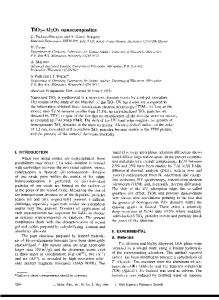XAFS Study of Fe K Edge in Al 2 O 3 -B 2 O 3 -Fe 2 O 3 -Na 2 O-SiO 2 Glasses
- PDF / 258,188 Bytes
- 6 Pages / 432 x 648 pts Page_size
- 94 Downloads / 370 Views
S.V. Stefanovsky,1,2 A.A. Shiryaev,2 Y.V. Zubavichus,3 K.M. Fox,4 J.C. Marra4 1
SIA Radon, 7th Rostovskii lane 2/14, Moscow 119121 Russia, [email protected] Institute of Physical Chemistry and Electrochemistry RAS, Leninskii av. 31, Moscow 119071 Russia 3 NRC “Kurchatov Institute”, Kurchatov sq. 1 123182, Moscow 119117 Russia 4 Savannah River National Laboratory, Building 773-A, Aiken 29808 U.S.A. 2
ABSTRACT Valence state and local environment of Fe in complex glasses related to the system Al2O3-B2O3Fe2O3-Na2O-SiO2 were studied. In all the glasses, the major fraction of Fe exists as Fe3+ ions but a minor fraction of Fe2+ ions especially in the glass with the lowest K=[SiO2]/[B2O3] ratio was also present. Average Fe⎯O distance in the first shell is 1.80-1.85 Å and coordination number is 4-6. The intensity due to the second sphere is rather weak demonstrating homogeneous distribution of Fe ions in the glass. INTRODUCTION Iron is a typical component of radioactive wastes occurring as both activated corrosion product and component of chemicals used in waste pre-treatment processes [1]. During waste vitrification, iron may have a significant effect on phase composition of glassy materials (spinel formation), their structure and properties (viscosity, rheology, electric resistivity of glassmelts and chemical durability of glasses) [2-4]. Fe2O3 in the presence of MgO, MnO, FeO, CoO, NiO forms spinel-type phases which have no impact on chemical durability of borosilicate glasses [4-7]. In the glass structure Fe2O3 can act similarly to Al2O3 and retard conversion of tri- to four-coordinated boron (but typically to a less extent than Al2O3). An extreme excess of Fe2O3 may result in phase separation and reduction in chemical durability of borosilicate glasses. Structural parameters R = R2O/B2O3 and K = SiO2/B2O3 (oxide concentrations are given in mol.%) for evaluation of relative fractions of three- and four-coordinated boron were proposed based on investigation of the structure of alkali borosilicate glasses [8]. For complex borosilicate glasses the R parameter is calculated from the expression [9]: R ={(Na2O+K2O+BaO)+[0.7(CaO+SrO+CdO+PbO)+[0.3(Li2O+MgO+ZnO)]-Al2O3}/B2O3 For the Fe2O3 bearing glasses this expression may be modifyed as [10]: RFe ={(Na2O+K2O+BaO)+[0.7(CaO+SrO+CdO+PbO)+[0.3(Li2O+MgO+ZnO)]-Al2O3-0.3Fe2O3}/B2O3, where all oxide concentrations are also given in mol.%, and for the glasses studied in the current work the expreessions are the following: R = (Na2O-Al2O3)/B2O3 and RFe = (Na2O-Al2O3-0.3Fe2O3)/B2O3, respectively (Table I). The methods of determination of Fe valence state and local environment in glass structure include techniques such as Mössbauer effect, electron paramagnetic resonance (EPR), and X-ray absorption spectroscopy (XAS). The latter is being extensively applied during recent years (see, for example, [1116]). This technique was used to study Fe speciation in complex Al2O3-B2O3-Fe2O3-Na2O-SiO2 glasses considered as models for nuclear waste glasses for immobilization of Savannah River Site (S
Data Loading...











